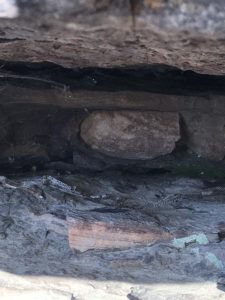
Norway maple leaf I took to press.
When I was on the phone with my mother on my way to my site, she asked me if all the trees in Vermont still had their leaves, I replied that yes, most trees still had their leaves but that all of those trees changed color—this was still on campus. This held true when I entered the woods at Salmon Hole to access my site today, I noticed that most trees still had many leaves despite there also being many leaves on the ground. I noticed that many of the leaves on the ground were bright yellow Norway Maple leaves, and I took one to press.

Bare eastern cottonwoods on the shore of the Winooski.
When I came out to the river, I noticed that the trees on the shore were either completely or almost bare of their leaves, pretty much regardless of species. The most bare were the large eastern cottonwoods by my center point, as well as some American beeches. I also observed some buckthorn plants, whose leaves were yellow-green and beginning to brown, but had yet to fall from their branches. I think that in addition to species losing their leaves at different times, a big reason why the trees on the shore are more bare is because they are more exposed to strong winds and similar disturbances, which would likely detach leaves more quickly, as opposed to trees in the woods which shield one another from strong wind.

Tree with missing patch of bark.

Fallen tree stripped of bark with mushroom growing from it.
In the time I spent observing the eastern cottonwoods, they reflected many activities in animal life to me. Though I previously noticed two trees with significant signs of being chewed on by beavers, today I observed a new patch of bark missing from a nearby cottonwood. The missing bark along with the frayed ends of remaining bark above and below the bark leads me to believe this is a beaver’s work. Another nearby fallen tree was stripped of all bark as well, though I do not know if that is related.

Cottonwood with woodpecker holes.
Additionally, I noticed this tree deeply cut into by beavers, as well as with some evidence of a woodpecker drilling holes into it. One of these holes appears slightly older, but the oblong holes with frayed bark are likely the work of a woodpecker.
On the topic of birds, I again saw gulls and also observed a pair of bluejays. I only saw one, but could hear the two calling to one another throughout my time at the site.
My most exciting discovery of the day was while looking at the rock outcrop I climb up and down to get to my center point, where I found old shedded snake skins in a crevice between the rocks. There were also many dead spiders in this space, and what were potentially small bone fragments. Unfortunately, I was not comfortable reaching in to check, but was able to take some pictures of the snake skin inside from outside the crevice.

Shedded snake skin found in the space between two large rocks.
